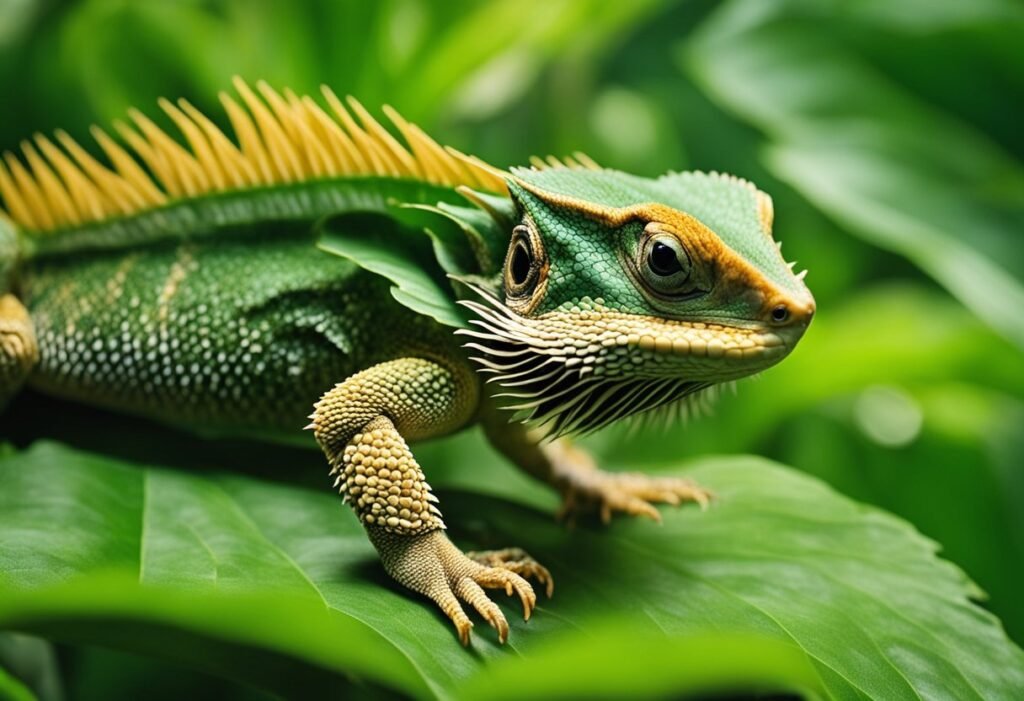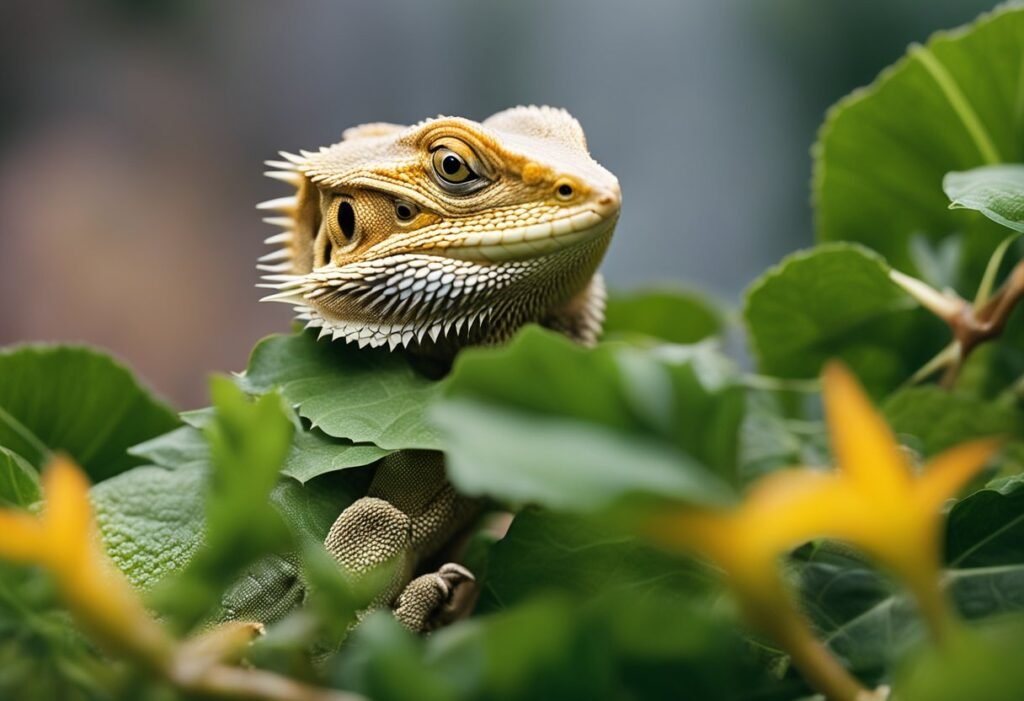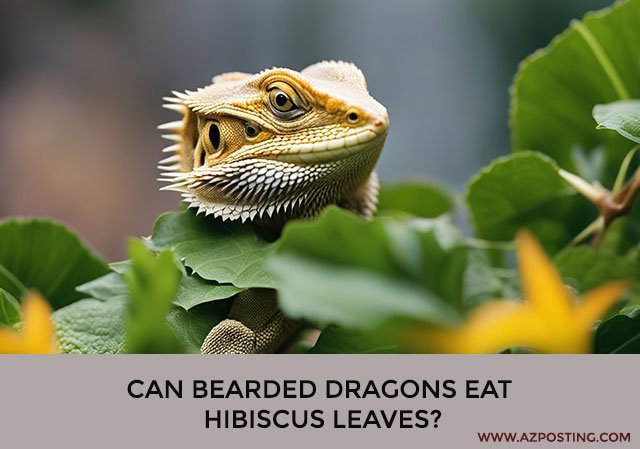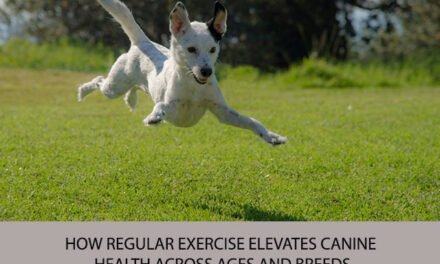Bearded dragons are a popular pet reptile known for their docile nature and unique appearance. As responsible pet owners, it’s important to ensure that our bearded dragons are receiving a balanced and nutritious diet. While commercial diets and insects are commonly fed to bearded dragons, many owners wonder if other foods, such as hibiscus leaves, are safe for their pets to consume.
Hibiscus plants are known for their vibrant flowers and are often used in teas and other culinary creations. However, their leaves are also edible and can provide a source of nutrition for some animals. When it comes to bearded dragons, it’s important to know whether or not hibiscus leaves are a safe option for their diet. In this article, we will explore the topic of whether or not bearded dragons can eat hibiscus leaves, examining the potential benefits and risks associated with feeding this plant to our reptilian companions.
Understanding Bearded Dragons’ Diet

Bearded dragons are omnivorous, which means they eat both plant and animal matter. In the wild, their diet consists mainly of insects, but they also eat fruits, flowers, and leaves. In captivity, it’s important to provide a balanced diet that meets their nutritional needs.
When it comes to feeding bearded dragons, it’s important to remember that not all plants are safe for them to eat. Some plants can be toxic and cause health problems, while others may not provide the necessary nutrients.
One plant that bearded dragons may come across is hibiscus. While hibiscus flowers are safe for them to eat, the leaves should be avoided. Hibiscus leaves contain high levels of oxalic acid, which can interfere with calcium absorption and lead to metabolic bone disease.
To ensure your bearded dragon stays healthy, it’s important to provide a varied diet that includes a mix of insects, vegetables, and fruits. Some good options include crickets, mealworms, kale, collard greens, and strawberries.
In addition to providing a balanced diet, it’s important to ensure your bearded dragon has access to clean water at all times. They may also benefit from vitamin and mineral supplements to ensure they’re getting all the nutrients they need.
Overall, understanding your bearded dragon’s diet is crucial to their health and well-being. By providing a balanced diet and avoiding potentially harmful foods, you can help ensure they live a long and healthy life.
Can Bearded Dragons Eat Hibiscus Leaves?
We have received a lot of questions about whether bearded dragons can eat hibiscus leaves, so we decided to investigate. After conducting research and consulting with reptile experts, we have come to a conclusion.
Hibiscus leaves are safe for bearded dragons to eat in moderation. However, they should not be a staple of their diet. Hibiscus leaves are high in oxalic acid, which can bind to calcium and prevent its absorption. This can lead to metabolic bone disease in bearded dragons.
If you decide to feed your bearded dragon hibiscus leaves, make sure to do so sparingly. It is recommended that hibiscus leaves make up no more than 10% of their diet. Additionally, be sure to provide your bearded dragon with a calcium supplement to ensure they are getting enough calcium.
It is also important to note that not all hibiscus plants are safe for bearded dragons. Some varieties, such as the Rose of Sharon, are toxic and should not be fed to your bearded dragon. Stick to the common hibiscus plant (Hibiscus rosa-sinensis) to be safe.
In summary, bearded dragons can eat hibiscus leaves in moderation, but they should not be a staple of their diet. Make sure to provide your bearded dragon with a calcium supplement and only feed them the common hibiscus plant to avoid any potential toxicity.
Benefits of Hibiscus Leaves for Bearded Dragons

Hibiscus leaves are a healthy addition to a bearded dragon’s diet. They offer a variety of benefits, including nutritional value and hydration. Here are some of the benefits of hibiscus leaves for bearded dragons.
Nutritional Value
Hibiscus leaves are rich in nutrients that are essential for a bearded dragon’s health. They contain high levels of vitamin C, which is important for maintaining a healthy immune system. They also contain vitamin A, which is essential for maintaining good vision and healthy skin.
In addition, hibiscus leaves are a good source of calcium, which is important for maintaining strong bones and teeth. They also contain iron, which is necessary for the production of red blood cells.
Hydration
Bearded dragons need to stay hydrated, and hibiscus leaves can help with that. These leaves are high in water content, which can help keep your bearded dragon hydrated. In addition, they contain potassium, which is important for maintaining proper hydration levels in the body.
It’s important to note that hibiscus leaves should not be the primary source of hydration for your bearded dragon. They should always have access to fresh water, and you should monitor their hydration levels closely.
In conclusion, hibiscus leaves are a healthy addition to a bearded dragon’s diet. They offer a variety of benefits, including nutritional value and hydration. However, they should be given in moderation and should not be the primary source of hydration for your bearded dragon.
Potential Risks of Hibiscus Leaves
Hibiscus leaves can be a healthy addition to a bearded dragon’s diet, but there are some potential risks to be aware of.
Pesticides and Chemicals
Hibiscus leaves can be treated with pesticides and other chemicals that may be harmful to your bearded dragon. It is important to only feed your bearded dragon hibiscus leaves that are organic or have been washed thoroughly to remove any chemical residue.
Overconsumption
While hibiscus leaves are safe for bearded dragons to eat, overconsumption can lead to health problems. Hibiscus leaves are high in oxalates, which can bind to calcium and prevent its absorption. This can lead to metabolic bone disease and other health issues.
It is important to feed hibiscus leaves to your bearded dragon in moderation, as part of a balanced diet that includes a variety of other vegetables and insects.
Overall, hibiscus leaves can be a healthy addition to a bearded dragon’s diet, but it is important to be aware of the potential risks and feed them in moderation.
How to Feed Hibiscus Leaves to Bearded Dragons

Feeding hibiscus leaves to bearded dragons can be a nutritious and tasty addition to their diet. Here are some tips on how to properly prepare and feed hibiscus leaves to your bearded dragon.
Preparation
Before feeding hibiscus leaves to your bearded dragon, it is important to properly prepare them. Here are the steps to follow:
- Wash the leaves thoroughly with water to remove any dirt or debris.
- Remove any wilted or damaged leaves.
- Cut the leaves into small, bite-sized pieces.
- Optional: lightly steam the leaves to make them easier to digest.
Feeding Frequency
While hibiscus leaves can be a healthy addition to your bearded dragon’s diet, it is important to feed them in moderation. Here are some guidelines to follow:
- Feed hibiscus leaves as a treat, not as a staple food.
- Offer hibiscus leaves once or twice a week.
- Do not feed hibiscus leaves exclusively, as this can lead to nutritional imbalances.
In conclusion, feeding hibiscus leaves to your bearded dragon can be a nutritious and tasty addition to their diet when done properly. Remember to always prepare the leaves thoroughly and feed them in moderation.
Alternatives to Hibiscus Leaves in Bearded Dragons’ Diet
If you are looking for alternative foods to feed your bearded dragon, there are plenty of options available. Here are some of the best alternatives to hibiscus leaves that you can consider:
1. Collard Greens
Collard greens are a great source of calcium, vitamin A, and vitamin C, making them an excellent addition to your bearded dragon’s diet. They are also low in oxalates, which can be harmful to your pet if consumed in excessive amounts.
2. Mustard Greens
Mustard greens are another great option for your bearded dragon. They are rich in vitamins A, C, and K, as well as calcium and iron. They also contain a good amount of fiber, which can help keep your pet’s digestive system healthy.
3. Dandelion Greens
Dandelion greens are a nutritious and delicious addition to your bearded dragon’s diet. They are rich in vitamins A, C, and K, as well as calcium, iron, and potassium. They also contain antioxidants that can help boost your pet’s immune system.
4. Turnip Greens
Turnip greens are another excellent source of vitamins A, C, and K, as well as calcium and iron. They are also low in oxalates, which makes them a safe and healthy option for your bearded dragon.
5. Endive
Endive is a leafy green vegetable that is rich in vitamins A and K, as well as calcium and potassium. It is also low in oxalates, which makes it a safe and healthy option for your pet.
Overall, there are plenty of alternatives to hibiscus leaves that you can feed your bearded dragon. Just make sure to provide a variety of foods to ensure that your pet receives all the nutrients it needs to stay healthy and happy.
Frequently Asked Questions

Are hibiscus leaves safe for bearded dragons to eat?
Yes, hibiscus leaves are safe for bearded dragons to eat. However, it is important to ensure that the leaves are free from any pesticides or chemicals that could be harmful to your pet.
Can hibiscus leaves be part of a bearded dragon’s diet?
Yes, hibiscus leaves can be a part of a bearded dragon’s diet. They are a good source of fiber and can provide some essential vitamins and minerals.
What are the benefits of feeding hibiscus leaves to bearded dragons?
Hibiscus leaves can provide some essential vitamins and minerals to bearded dragons, including vitamin C, calcium, and iron. They are also a good source of fiber, which can help with digestion.
Are there any risks associated with feeding hibiscus leaves to bearded dragons?
While hibiscus leaves are generally safe for bearded dragons, there are some risks to keep in mind. Hibiscus leaves contain oxalic acid, which can bind to calcium and prevent its absorption. This can lead to metabolic bone disease if your bearded dragon’s calcium intake is not properly balanced.
Can bearded dragons eat other types of flowers besides hibiscus?
Yes, there are other types of flowers that bearded dragons can eat, such as dandelions, pansies, and nasturtiums. However, it is important to research each type of flower before feeding it to your pet to ensure that it is safe for them to eat.
Is it okay to feed bearded dragons raw hibiscus leaves?
Yes, it is okay to feed bearded dragons raw hibiscus leaves. However, it is important to thoroughly wash the leaves and remove any stems or flowers before feeding them to your pet. Additionally, it is recommended to feed hibiscus leaves in moderation as part of a balanced diet.





